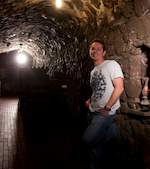But of all the influences during this time, one looms large: Eloi Dürrbach of Domaine de Trévallon in Provence, where he worked a vintage. 'That's where I learned a lot about wine, as opposed to winemaking. He would always be opening some great bottle of wine at mealtimes and sharing it.'

'As a winemaker you must try to spend money on great wine, and keep tasting the best that's out there.'
A Parisian architect, son of a painter and sculptor who was a friend of Picasso, Dürrbach took early retirement and built a winery on his family farm, disregarding appellation laws to make a cabernet sauvignon/ shiraz blend because he felt the varieties were right for the terroir. Despite his wine subsequently being 'downgraded' to a humble Vin de Pays, it still won great acclaim.
'He took a stand against the age-old, handed-down, unquestioned ways and planted something he knew would do well in that terroir. But more than that, I saw someone making a wine that HE loved: it was not about convention, market trends, or impressing the critics. I learned that to make good wine, you have to follow that which is your passion.'
Gottfried Mocke is doing exactly that on Cape Chamonix in the Franschhoek Valley where he accepted the position of assistant winemaker upon his return to South Africa in 2001, becoming winemaker after just two months on the job.
'I was always going to return to the Cape; besides, I missed my family; I'm very [amilievas [family orientated].' He confesses he never originally envisaged himself in the Franschhoek Valley, but upon visiting Chamonix, already with a reputation for chardonnay and exploring pinot noir, he knew it was the place for him.
'The boss and I just clicked, right from the start. It was only later that we discovered that he'd known my late grandfather, who used to grow grapes at Stormsvlei between Robertson and Swellendam. He likes to say I was "meant" to find my way to Chamonix.'
'The boss' is Chris Hellinger, multimillionaire German-South African businessman with interests in Angolan diamond mines and tourism developments on the West African islands of Sao Tome and Principe. Besides the rejuvenation of Chamonix as a wine farm, Hellinger also established a business bottling and supplying water from the farm's mountain spring for leading national bottled water brands. Hellinger bought the property in 1990.
A portion of the larger seventeenth-century French Huguenot wine farm La Cotte, it had been re-named Chamonix by its former owners after the eponymous French village they had loved and was largely under fruit trees with some vineyard.
Wines had previously been made at the Franschhoek co-operative winery. Hellinger's restoration of what was to become known as Cape Chamonix included the replanting and new planting of vines, and an underground production and maturation cellar, with a tunnel for bottle ageing wines and bottle fermenting bubbly.
Under the farm's first winemaker the farm became known, not only for its chardonnays and sauvignon blancs, but also reds, specifically cabernet sauvignon. New plantings of pinot noir were beginning to show potential.
 Chicken and clam tomato casserole recipe by Gottfried Mocke served with couscous and paired with Cape Chamonix Pinot Noir Reserve wine....
Chicken and clam tomato casserole recipe by Gottfried Mocke served with couscous and paired with Cape Chamonix Pinot Noir Reserve wine.... Sheep’s Pluck in sweet-and-sour sauce recipe by Gottfried Mocke served with fresh ciabatta and paired with Cape Chamonix Chardonnay Reserv...
Sheep’s Pluck in sweet-and-sour sauce recipe by Gottfried Mocke served with fresh ciabatta and paired with Cape Chamonix Chardonnay Reserv...